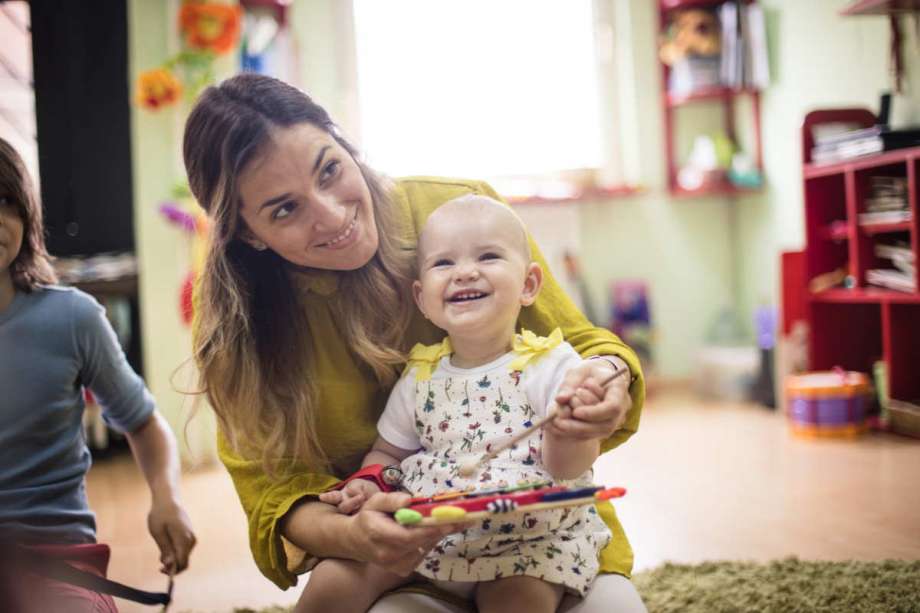10 Ways You Can Help Your Baby Learn

As a new mother, I remember feeling so anxious about how we were going to teach our son everything he needed to know to succeed in life. Having been raised by a mother who thought of her children as empty vessels who needed to be filled up by adults,
I imagined the exhaustion of years of trying to pack everything into his head.
It felt like an overwhelming task lasting years and years. Imagine how unburdened I felt when we began going to Magda Gerber’s RIE Parent-Infant Guidance Class, and discovering through her guidance that my baby was, for the most part, quite capable of learning what he needed to know in most situations without any deliberate teaching at all! It was not on my head to make him smart. He was innately smart and capable of learning.
More: 12 Simple Developmental Activities to Try with Your Tot
I began to notice he was constantly conducting physics and engineering experiments with the objects in his reach, physical experiments with his own body as he learned to sit, stand and walk, and social science experiments as he watched the faces of adults and other babies as he interacted with them, making inferences and evaluations based upon what happened during these experiments. He chose just the activity he needed to test his hypotheses. I could see that he was working on questions, like:
- What fits where?
- What things roll and what things don’t?
- How heavy is this?
- How far can I push it? Throw it? Kick it?
- How does it sound if I bang it on this? On that?
- What do things feel like? (Oops, must teach poking eyes isn’t a good thing to do!)
- Is this toy soft or hard to bite? How about this arm? (OK, selective guidance sometimes comes in handy.)
You get the idea. They learn that metal is hard, and sponges are soft, without direct teaching. They learn what fits where, not by being instructed, but by trying it out, over and over. My favorite thing is when toddlers all of a sudden get that the hair curlers they’ve been mouthing and nesting, can fit into a big 5-gallon water jug. No one shows them how to do this; they just invent it by inspiration and experimentation.
So, if direct teaching is not what infants and young children need, what should we do? Here are a few suggestions to get you started:
Pin it to save for later:
1)Find a comfortable spot to sit low, and unobtrusively observe without unnecessary talking.
2)Offer simple, sturdy objects, like cups or bowls that nest, wooden utensils, balls, boxes and other containers for putting things in and taking things out; include things that are safe to mouth. Offer different materials, such as wood, stainless steel, cloth, objects from nature, and food-grade synthetic materials like silicone and safe plastics.
3)Don’t give toys that require adult help. If there’s nothing interesting they can do with it without your help, it’s too advanced. Avoid battery-operated toys for infants and toddlers, and opt for basic toys. We want the child to create the action, not hidden mechanisms and batteries.
4)When they get involved with something, keep watching silently so as not to interrupt their experiments. Try to discern what “problem” they are solving or skill they are developing. Resist the temptation to help.
5)When they look at you for a reaction, name the object(s) and describe in simple words what they are doing. (“You are having fun throwing the big red ball!” Or, “It’s hard to fit the square block into the round hole.”)
6)Don’t tell them what to do with the object; they will figure it out. Not all problems need solving today.
7)If they do something unsafe or inappropriate, explain why they will not be allowed to continue. Say what they can safely do. (“I can’t let you throw the blocks; they might hurt someone. They are hard. You can throw the balls inside because they are light.”)
8)Remember that the child needs to explore many options. Don’t judge the child for his curiosity and creativity, even if a limit must be set. Your authority is an important part of their safety, when you also respect their need to try things. (“I know it feels great to throw heavy things. We can do that outside later, but not inside.”)
9)If the child wants you to play too, follow her lead. If she’s using a cup like a telephone, don’t correct her and say it’s for drinking. Enter her reality. “Answer” the other cup!
10)Realize that your appreciative attention is enough; they don’t need praise for doing what comes naturally.
By allowing your child to learn in their own way, you will have a smart child. Unburden yourself and enjoy the show!
Looking for more ways to keep kids learning and playing? Check out Why Independent Play is Vital for Raising Empowered Children.
Ruth Anne Hammond, consultant and author of Respecting Babies: A Guide to Educaring for Parents & Professionals 2nd Edition (Zero to Three 2019), is a RIE® Mentor, and former President of Resources for Infant Educarers®. She was faculty in the Human Development Department at Pacific Oaks College & Children's School, as well as head of its Infant/Toddler-Parent Program. Hammond studies affective neuroscience with Dr. Allan N. Schore.